仁爱版八年级英语上册Unit3,Topic1教案
- 格式:doc
- 大小:103.00 KB
- 文档页数:7
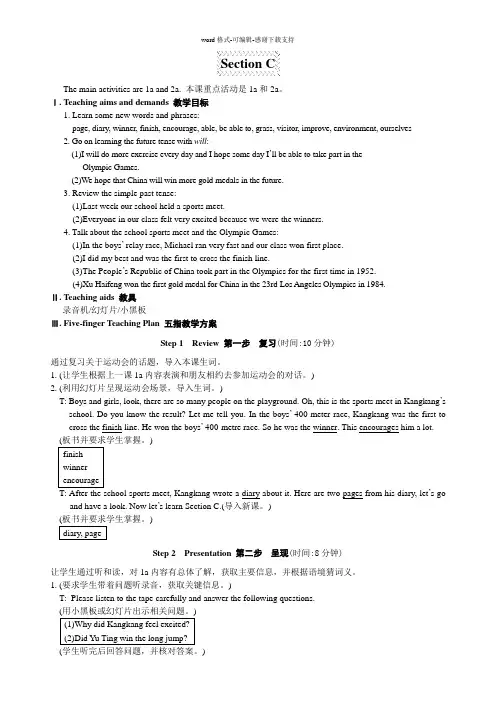
Section CThe main activities are 1a and 2a. 本课重点活动是1a和2a。
Ⅰ. Teaching aims and demands 教学目标1. Learn some new words and phrases:page, diary, winner, finish, encourage, able, be able to, grass, visitor, improve, environment, ourselves2. Go on learning the future tense with will:(1)I will do more exercise every day and I hope some day I’ll be able to take part in theOlympic Games.(2)We hope that China will win more gold medals in the future.3. Review the simple past tense:(1)Last week our school held a sports meet.(2)Everyone in our class felt very excited because we were the winners.4. Talk about the school sports meet and the Olympic Games:(1)In the boys’ relay race, Michael ran very fast and our class won first place.(2)I did my best and was the first to cross the finish line.(3)The People’s Republic of China took part in the Olympics for the first time in 1952.(4)Xu Haifeng won the first gold medal for China in the 23rd Los Angeles Olympics in 1984.Ⅱ. Teaching aids 教具录音机/幻灯片/小黑板Ⅲ. Five-finger Teaching Plan 五指教学方案Step 1 Review 第一步复习(时间:10分钟)通过复习关于运动会的话题,导入本课生词。
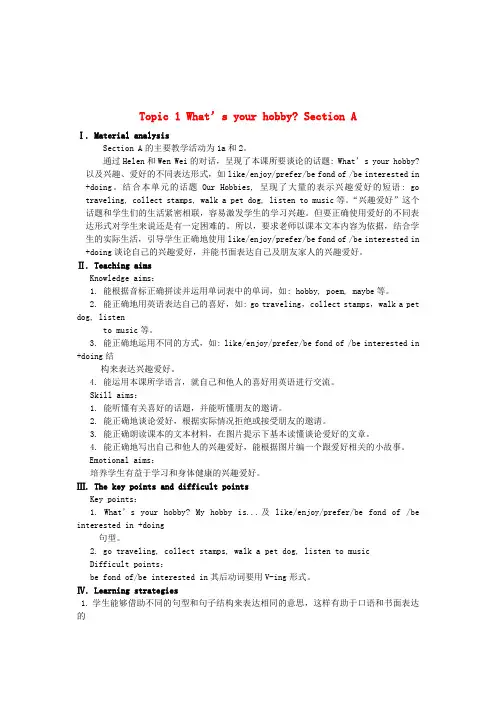
Topic 1 What’s your hobby? Section AⅠ. Material analysisSection A的主要教学活动为1a和2。
通过Helen和Wen Wei的对话,呈现了本课所要谈论的话题: What’s your hobby?以及兴趣、爱好的不同表达形式,如like/enjoy/prefer/be fond of /be interested in +doing。
结合本单元的话题Our Hobbies, 呈现了大量的表示兴趣爱好的短语: go traveling, collect stamps, walk a pet dog, listen to music等。
“兴趣爱好”这个话题和学生们的生活紧密相联,容易激发学生的学习兴趣。
但要正确使用爱好的不同表达形式对学生来说还是有一定困难的。
所以,要求老师以课本文本内容为依据,结合学生的实际生活,引导学生正确地使用like/enjoy/prefer/be fond of /be interested in +doing谈论自己的兴趣爱好,并能书面表达自己及朋友家人的兴趣爱好。
Ⅱ. Teaching aimsKnowledge aims:1. 能根据音标正确拼读并运用单词表中的单词,如: hobby, poem, maybe等。
2. 能正确地用英语表达自己的喜好,如: go traveling,collect stamps,walk a pet dog, listento music等。
3. 能正确地运用不同的方式,如: like/enjoy/prefer/be fond of /be interested in +doing结构来表达兴趣爱好。
4. 能运用本课所学语言,就自己和他人的喜好用英语进行交流。
Skill aims:1. 能听懂有关喜好的话题,并能听懂朋友的邀请。
2. 能正确地谈论爱好,根据实际情况拒绝或接受朋友的邀请。

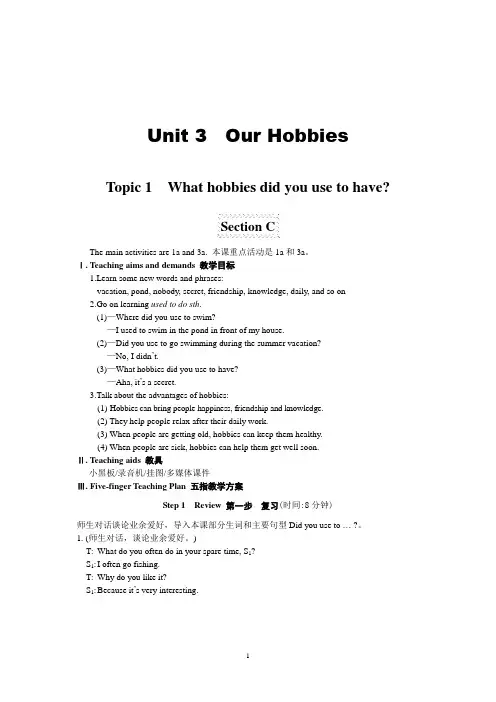
Unit 3 Our Hobbies Topic 1 What hobbies did you use to have?Section CThe main activities are 1a and 3a. 本课重点活动是1a和3a。
Ⅰ. Teaching aims and demands 教学目标1.Learn some new words and phrases:vacation, pond, nobody, secret, friendship, knowledge, daily, and so on2.Go on learning used to do sth.(1)—Where did you use to swim?—I used to swim in the pond in front of my house.(2)—Did you use to go swimming during the summer vacation?—No, I didn’t.(3)—What hobbies did you use to have?—Aha, it’s a secret.3.Talk about the advantages of hobbies:(1) Hobbies can bring people happiness, friendship and knowledge.(2) They help people relax after their daily work.(3) When people are getting old, hobbies can keep them healthy.(4) When people are sick, hobbies can help them get well soon.Ⅱ. Teaching aids 教具小黑板/录音机/挂图/多媒体课件Ⅲ. Five-finger Teaching Plan 五指教学方案Step 1 Review 第一步复习(时间:8分钟)师生对话谈论业余爱好,导入本课部分生词和主要句型Did you use to … ?。
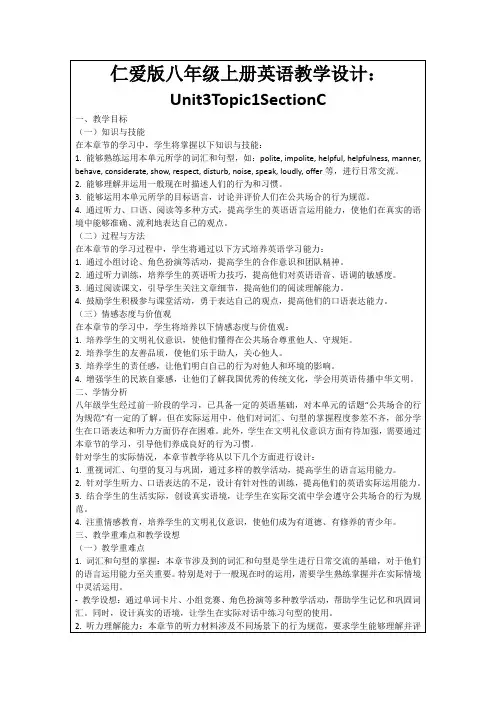
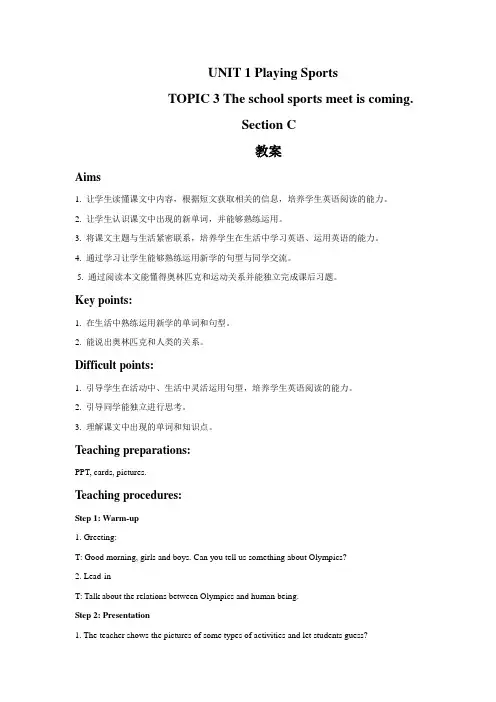
UNIT 1 Playing SportsTOPIC 3 The school sports meet is coming.Section C教案Aims1. 让学生读懂课文中内容,根据短文获取相关的信息,培养学生英语阅读的能力。
2. 让学生认识课文中出现的新单词,并能够熟练运用。
3. 将课文主题与生活紧密联系,培养学生在生活中学习英语、运用英语的能力。
4. 通过学习让学生能够熟练运用新学的句型与同学交流。
5. 通过阅读本文能懂得奥林匹克和运动关系并能独立完成课后习题。
Key points:1. 在生活中熟练运用新学的单词和句型。
2. 能说出奥林匹克和人类的关系。
Difficult points:1. 引导学生在活动中、生活中灵活运用句型,培养学生英语阅读的能力。
2. 引导同学能独立进行思考。
3. 理解课文中出现的单词和知识点。
Teaching preparations:PPT, cards, pictures.Teaching procedures:Step 1: Warm-up1. Greeting:T: Good morning, girls and boys. Can you tell us something about Olympics?2. Lead-inT: Talk about the relations between Olympics and human being.Step 2: Presentation1. The teacher shows the pictures of some types of activities and let students guess?展示一些运动的图片,询问同学们这是谁?T: Do you know this is?T: Can you tell us something about this sport?T: I know something about this sport for it’s an important part to constitute sports activities.S: I know…2. The teacher shows the pictures of new words on the blackboard.T: Let’s read the new words.3、看着照片提问题:a. How many activities in the Olympics do you know?b. Do you like this activity?c. What are they doing?4、老师参照课件为同学们展开单词教学。
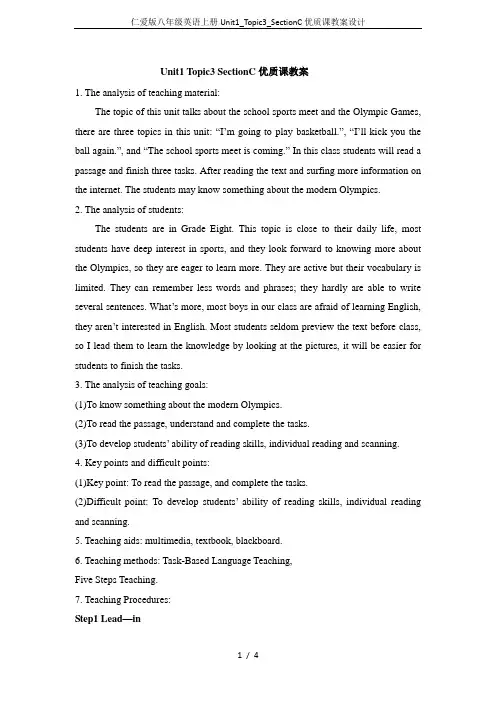
Unit1 Topic3 SectionC优质课教案1. The analysis of teaching material:The topic of this unit talks about the school sports meet and the Olympic Games, there are three topics in this unit: “I’m going to play basketball.”, “I’ll kick you the ball again.”, and “The school sports meet is coming.” In this class students will read a passage and finish three tasks. After reading the text and surfing more information on the internet. The students may know something about the modern Olympics.2. The analysis of students:The students are in Grade Eight. This topic is close to their daily life, most students have deep interest in sports, and they look forward to knowing more about the Olympics, so they are eager to learn more. They are active but their vocabulary is limited. They can remember less words and phrases; they hardly are able to write several sentences. What’s more, most boys in our class are afraid of learning English, they aren’t interested in English. Most students seldom preview the text before class, so I lead them to learn the knowledge by looking at the pictures, it will be easier for students to finish the tasks.3. The analysis of teaching goals:(1)To know something about the modern Olympics.(2)To read the passage, understand and complete the tasks.(3)To develop students’ ability of reading skills, individual reading and scanning.4. Key points and difficult points:(1)Key point: To read the passage, and complete the tasks.(2)Difficult point: To develop students’ ability of reading skills, individual reading and scanning.5. Teaching aids: multimedia, textbook, blackboard.6. Teaching methods: Task-Based Language Teaching,Five Steps Teaching.7. Teaching Procedures:Step1 Lead—inLet’s enjoy a song: Pass the flame.The teacher asks students: Do you like this song? And do you know what the song is about?Pass the flame is the theme song of the Olympic Games in Athens in 2004. Do you want to know more about the Olympics?Step2 Presentation (pre—reading)Teacher shows some pictures about the modern Olympics on the PPT, let students find out the years and the host cities. They should learn to say these sentences:The modern Olympics started in Athens, Greece in______.In 2000 ______ held the 27th Olympic Games.In 2004______ hosted the28th Olympic Games.______ hosted the 29th Olympic Games in 2008.London held the 30th Olympics in______.The 31st Olympics was held in ______ in2016.Then ask them to think about the two questions:Do you know when the next Olympics will be held?Which city will host the next Olympic Games?Activity 1: Match the years with the host cities of the Olympic Games.2000 Rio2004 London2008 Beijing2012 Athens2016 SydneyNext we will learn: the symbol of the Olympics and what do the five rings stand for? Olympic motto is: Faster, Higher, Stronger!Step3 Practice (while—reading)Task 1: Read the passage 1a and choose the correct answers.( ) 1. The modern Olympics started in______.A. 1952B. 1896C. 1996D. 2000( ) 2. What is the symbol of the Olympic Games?A. The Olympic emblems(会徽)B. The Olympic mascots (吉祥物)C. The Olympic ringsD. The flag of each country( ) 3. What do the five rings stand for?A. Five parts of the worldB. Five countriesC. Five citiesD. Five colors( ) 4. The Olympic Games are held every ______ years.A. 2B. 3C. 4D. 5( ) 5. Which of the following is TRUE?A. You can find one color in the flag of each country.B. The players from all over the world meet to compete and they can’t be friends.C. Only in Athens the Olympic motto is “Faster, Higher, and Stronger.”D. The Olympic Games will be more and more popular and exciting.While students doing this part, the teacher writes down the key words and phrase on the black board, after finishing the task, teacher retells the passage according to these tips.Task 2: Retell the passageThe modern Olympics started in Athens, Greece in ______. Its motto is “Faster, ______, Stronger”. The Olympic rings are a ______ of the Olympic Games. There are five rings, and they______ (代表)the five parts of the world. The ______ and Winter Olympics are held every four years. Nowadays, different cities hold the Olympics Games______(轮流). The Olympics are becoming______(越来越.......)popular and exciting.Step4 Summary: complete the notes (post—reading)1. The year of the first modern Olympics: __________________________________.2. The host city of the first modem Olympics:_________________________________.3. The motto of the Olympics Games:_______________________________________.4. The symbol of the Olympics Games:______________________________________.6. The colors of the rings:________________________________________________.7. The Summer Olympic Games are held every______ years.Step5 Homework1. Read this passage aloud.2. Finish part 2, 3 on page 228. Blackboard designTopic 3 The school sports meet is coming. (Section C)The modern OlympicsStarted in: 1896Stand for: the five parts of the worldBe held: every four yearsIn the future: more and more excitingThe Olympic motto: Faster, Higher, Stronger!9. Teaching reflectionIn this class, I think there are three successful points:(1) Listen to a song to attract students’ interest.(2) Lead students to learn more by reading other materials.(3) I integrate the textbook effectively that can make students understand easily. But there is also shortcoming, I pay less attention to individual students, focus on their learning results.I believe I will do better after my hard work.。
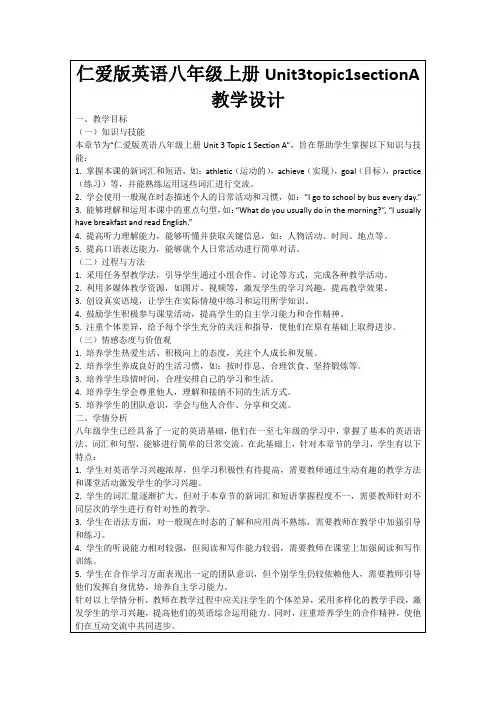

八年级上册教案设计Unit1PlayingSportsTopic3Theschoolsportsmeetiscoming.SectionAⅠ.Materialanalysis本节课的主要活动为1a和2b。
SectionA对话里,YuTing和LiMing兴奋地谈论即将到来的运动会,呈现了本课所要学的语法重点FutureTensewithwill。
YuTing和LiMing饶有兴趣地围绕Whichsportwillyoutakepartin?谈论着各自参加的运动会项目,呈现了重点短语:theboys’800-meterrace,beinthelongjump等。
本对话呈现了孩子们积极上进的学习生活,要求学生在学会课本语言知识的同时,向YuTing和LiMing学习,积极参与学校各项集体活动,在培养集体主义思想的同时,培养自己自信、上进的个人素质。
Ⅱ.TeachingaimsKnowledgeaims:1.能正确运用以下短语进行书面表达:theboys’800-meterrace,beinthelongjump,havelotsof fun,preparefor,makemanyfiends,makefriendswithsb.等。
2.能正确地理解下列句子和短语:Theschoolsportsmeetiscoming.thecomingschoolsportsmeet3.能正确理解并运用will将来时,能运用will进行造句。
Skillaims:1.能听懂有关运动会项目的名称及相关话题。
2.能熟练地运用will引导的将来时谈论有关运动会的话题。
3.能正确朗读介绍运动会项目的对话或文章。
4.能用will将来时介绍自己或朋友在运动会中参加的项目。
Emotionalaims:通过学习YuTing和LiMing积极上进的对话内容,鼓励学生要积极参与学校集体活动,培养自己乐观、自信、乐于合作的优良品质。
Ⅲ.ThekeypointsanddifficultpointsKeypoints:theboys’800-meterrace,beinthelongjump,havelotsoffun ,preparefor,makemanyfriends,makefriendswithsb.等短语的理解及运用。
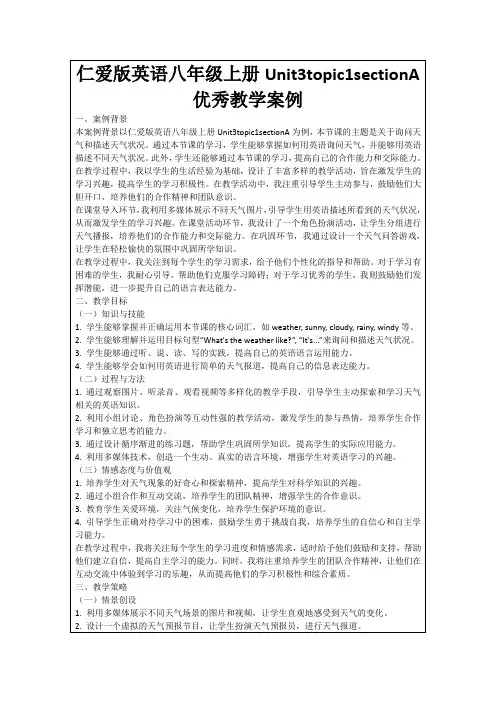
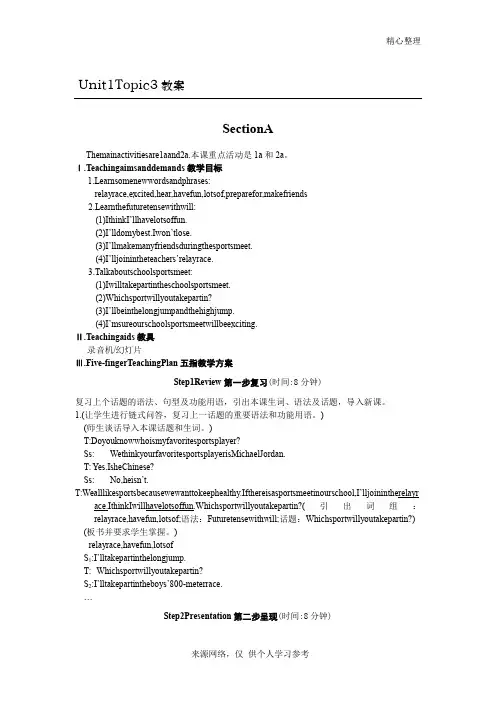
精心整理Unit1Topic3教案SectionAThemainactivitiesare1aand2a.本课重点活动是1a和2a。
Ⅰ.Teachingaimsanddemands教学目标1.Learnsomenewwordsandphrases:relayrace,excited,hear,havefun,lotsof,preparefor,makefriends2.Learnthefuturetensewith will:(1)Ithink I’llhavelotsoffun.(2)I’lldomybest.Iwon’tlose.(3)I’llmakemanyfriendsduringthesportsmeet.(4)I’lljoinintheteachers’relayrace.3.Talkaboutschoolsportsmeet:(1)Iwilltakepartintheschoolsportsmeet.(2)Whichsportwillyoutakepartin?(3)I’llbeinthelongjumpandthehighjump.(4)I’msureourschoolsportsmeetwillbeexciting.Ⅱ.Teachingaids教具录音机/幻灯片Ⅲ.Five-fingerTeachingPlan五指教学方案Step1Review第一步复习(时间:8分钟)复习上个话题的语法、句型及功能用语,引出本课生词、语法及话题,导入新课。
1.(让学生进行链式问答,复习上一话题的重要语法和功能用语。
)(师生谈话导入本课话题和生词。
)T:Doyouknowwhoismyfavoritesportsplayer?Ss: WethinkyourfavoritesportsplayerisMichaelJordan.T: Yes.IsheChinese?Ss: No,heisn’t.T:Wealllikesportsbecausewewanttokeephealthy.Ifthereisasportsmeetinourschool,I’lljoinintherelayr ace.IthinkIwillhavelotsoffun.Whichsportwillyoutakepartin?(引出词组:relayrace,havefun,lotsof;语法:Futuretensewith will;话题:Whichsportwillyoutakepartin?) (板书并要求学生掌握。
《仁爱版》八年级英语(上)Unit 3 Our HobbiesTopic 1 What habbies did you use to have?Section B教案设计The main activities are 1a, 3a and 4.I. Teaching aims and demands:a. Knowledge objectives:(1) To enable my students to understand new words and phrases, “ share, e-mail address, VCD, pop music, in one’s spare time, comic”.(2) Learn the pattern of “used to”.(3) Go on talking about interests and hobbies not only now but also in the past and learn how to express likes and dislikes.b. Ability objectives(1) To devel op my students’ listening, reading and speaking strategies.(2) To develop the students’ vocabulary about hobbies and interests.(3) To enlarge the students’ sense of cooperation in their studies through activitiesc. Moral objectives(1) To guide my students into a better understanding that if you share, you will be happy.(2) To increase my students’ interest in learning English.(3) To strengthen their confidence in learning English.II. Teaching keys and difficulties1. To express their hobbies not only now, but also in the past.2. How to instruct Ss to share and cooperate with others.III. Teaching aidsboard, tape recorder, PPT, OHP, and some material objects, such as oranges, VCDs, comics and cards.IV. Teaching proceduresStep 1 Warm up and lead in1. Listen and sing a song called “Are you happy?” before the class.2. Greeting.3. Ask the Ss, “Are you happy if I share my orange?”And teach the new word-----share.eg:4. Using “share” to go on teaching the new words“e-mail address, VCD, spare, in one’s spare time, and comic.”eg:Step 2 Review1. Share hobbies with the Ss.a. Tell the Ss my hobbies, then encourage the Ss to tell me theirsb. While talking, use the brainstorming to review what hobbies we have learnt.eg:Step 3 (part 2) Look, listen and match1. Tell the Ss we have 8 more friends to share their hobbies with us, but we need to match their hobbies with the right English phrases.2. Let the Ss look and match3. Have the Ss listen to the tape recorder and number the sentences with the pictures.eg:Step 4 (1a) Look, listen and say.1. Listen and answer 2 questions.What does Wen Wei often do in his spare time?What’s Helen’s hobby?2. Let the Ss read the conversation in roles.First, the boys will be Wen Wei and the girls will be Helen.Then, change the boys’ and the girls’ roles.After that, ask two pairs to act it out.3. Pair workLet the Ss share hobbies like what Helen and Wen Wei do with their partners.First give them an example.Then give them 3 minutes to practise.After that, ask 2 or 3 pairs to show their dialogues.Step 5. (3a) Read and understand1. Use my own experience to lead in “used to”T: I used to dance, but now I don’t like it. I like reading comics.eg:2. Read 3a for the first time to fill in the blanks.He used to be a _______ fan, but now he is _________.He used to _______ , but now his hobbies are _______.He used to ________, but now he likes _________.Let the Ss compare “used to” and “now”3. Read 3a again and choose the right answersHe ____________a soccer fan.A. used to beB. didn’t use to beHe ____________ enjoy sports.A. used toB. didn’t use toHe ____________like collecting paintings.A. used toB. didn’t use toLet the Ss compare “used to” and “didn’t use to”Step 6 (part 4) Group work1. To give everyone a paper to do a survey.eg:2. Ask them to share hobbies with their classmates, and get their hobbies as many as they can.3. Make an example for the SsFirst ask them to write down their classmates’ or friends’ names.Then use the Q: Can you tell me your hobbies?Tell them that their answers can be one of these: Yes, I enjoy cooking now.I didn’t use to read comics, but now I like it.I used to dance, but now I hate it.4. If the Ss don’t understand, give one more example.5. Give the Ss about 5 minutes to do it.6. After that, ask some individuals to tell about his or her hobbies and his or her friends’ hobbies.Step 7 Summary1. Review the new words and the phrasesshare, e-mail address, VCD, pop music, in one’s spare time, comic2. Review the key sentences.What do you often do in your spare time?I often go fishing.I used to listen to music, but now I hate it.I didn’t use to play soccer, but now I like it.Step 8 Project and Homework1.Oral work:A. Read the dialogue and the passage 5 times to your friends.B. Make a conversation with your friend and act it to 2 of your classmates(Ask your friends to sign their names on your book after you finish your Oral Work)2. Written work:A. Make a brainstorming, you must write at least 10 hobbies.B: Write 3 sentences about hobbies.板书设计:Unit 3 Our HobbiesTopic 1 What hobbies did you use to have?Section BKey words Key Sentencesshare What do you often do in your spare time?e-mail address I often go fishing.VCDpop music I used to listen to music, but now I hate itsparecomic I didn’t use to play soccer, but now I like it.Reflecting (教学反思)本节课主要针对本班学生已具备的英语素质和对英语学习的热情而设计的,并且充分利用了现有的教育教学资源,以新课标精神为指导思想,努力改善学生学习的方式。
Unit 3 Topic 1 What’s your hobby?Section C【教学构思】一、教材分析:本课属于课标话题人与自我——“个人情况(Personal background)”中兴趣与爱好(Interests and hobbies)项目,主要谈论制作剪贴簿本课属于课标功能意念表“态度(Attitudes)”中偏爱和优先选择(Preference)项目,主要学习收集和制作剪贴簿,并激发学生了解剪贴簿的兴趣。
主要教学活动为1a和2。
通过介绍scrapbook的制作,呈现了单词background,paper,glue,scissors,stick,friendship,stupid等。
通过scrapbook的制作过程,引出在谈论事情或制作的时候需要注意条理性。
在2中也将used to do sth.延伸到特殊疑问句形式。
最后,引导学生能模仿scrapbook的制作过程,用英文讲述a class book的制作过程。
二、设计说明:根据学情和本课的语法及话题,本节课的教学设计将读与写相结合,以1a阅读文本为载体,学会通过图片和语境猜词,学会把握文章主题和篇章结构,构建思维导图;在语言生成阶段,循序渐进,从文本理解到课文复述,帮助学生完成写作任务。
本课在重、难点突破的方法上有所创新,教师通过2的对话延伸used to do sth.的特殊疑问句形式,通过梳理阅读文本结构,引导学生构建读后思维导图,引导学生在说和读的基础上,通过关键词句,确立写作思路和基本框架,进行创作。
【教学目标】1.能基本听懂本课文本材料,及他人对爱好的阐述,学会以“听”的方式理解语言意义;2.能正确地口头介绍scrapbook的制作流程,构建语言意识,提升“说”的语言能力;3.能正确朗读课本的文本材料,并能读懂相关的文本材料,培养学生“读”的语言能力;4.能正确模仿本课课文,通过书面形式介绍a class book的制作过程,发展学生多元学习策略,提高“写”的语言能力。
八年级上册教案设计Unit3OurHobbiesTopic1What’syourhobby?SectionBⅠ.MaterialanalysisSectionB的主要教学活动为1a和3。
本节课主要通过Michael,Maria和Kangkang之间的对话,继续学习表示兴趣爱好的话题。
SectionB是对SectionA的延伸,谈论的内容也从谈论现在的兴趣爱好扩展到了对过去兴趣爱好的谈论,即usedtodosth和它的否定形式usednottodosth/didn’tusetodosth。
本小节第3部分主要谈论过去和现在爱好的对比。
学生们对兴趣爱好的话题很感兴趣。
但是要正确使用usedtodosth表达过去的兴趣爱好,也是有困难的,所以在设计这堂课的时候,老师应该将语言知识、语言点融入实际生活当中,让学生感受到本话题的实用价值。
能够在生活中自由谈论现在和过去的兴趣爱好并能够进行书面表达。
Ⅱ.TeachingaimsKnowledgeaims:1.能根据音标,正确朗读出下列单词及简单短语:collection,doll,coin,pop,usedtodosth。
2.能在老师的引导下,判断出S在清辅音、元音、浊辅音和ts/ds中的不同发音。
3.能正确拼读并运用单词表中的单词,如:coin,hate,pop等。
4.能用usedtodosth/usednottodosth/didn’tusetodosth表示过去的兴趣爱好。
5.能运用本课所学语言,对过去和现在的兴趣爱好进行对比。
Skillaims:1.能听懂有关过去的兴趣爱好和现在的兴趣爱好进行对比的简单对话和陈述。
2.能正确地口头表达有关喜欢和不喜欢及它们的过去式的话题。
3.能正确朗读课本的文本材料,准确把握语音、语调及连读。
4.能正确地运用书面表达写出自己和他人现在及过去的兴趣爱好。
Emotionalaims:通过对SectionB的学习,要求学生明白在不同的兴趣爱好中,可以增加不同领域的知识。
八年级上册教案设计Unit1 Playing SportsTopic3The school sports meet is coming.Section CⅠ. Material analysis本节课的主要活动为1a 和4。
通过阅读The Modern Olympics, 拓展了学生的视野。
在预习本课时,学生需要从报纸、杂志、络搜寻大量的有关奥运会的相关知识,培养了学生主动探究的精神。
本课有关奥运会的话题,让学生了解了奥运会的历史开展过程,明白运动的历史意义,有助于深化学生对运动的热爱之情,从而促进学生们积极主动地参加运动,让自己的身体更加健康。
本课稳固了本话题的语法重点Future Tense with will,呈现了重点短语:stand for, every four years, become more and more popular, have the chance to do sth.等。
课后要求学生能结合本单元内容,写一篇介绍自己学校运动会的文章。
Ⅱ. Teaching aimsKnowledge aims:1. 能正确拼读以下单词:modern, Olympics, ring, stand, least, chance, whether, gold;能明白以下单词或短语的含义:motto, symbol, stand for, at least, nowadays, compete, host, beginning, medal.2. 能在英语对话或文章中听懂、读懂以下短语:stand for, every four years, become more and more popular, have the chance to do sth.等。
3. 能正确地理解以下句子并能加以运用:In the future, more cities will have the chance to hold the Olympics.The Olympic Games will be more exciting.The Olympics are becoming more and more popular.Skill aims:1.能听懂有关奥运会的对话及类似的英语文字材料。
Unit1 Topic3 Section C 优质课教案(湖南省)一、教学目标(1)knowledge objects: talk about Olympics, students are expected to learn the use will/shall structure.(2)ability objects: students are encouraged to use some methods of reading skills to get a better understanding of the who le text.(3)moral objects Students are expected to feel more proud of being Chinese and study hard to realize the Olympic dreams.二、学情分析1.This unit mainly talks about sports. Section C is focused on the modernOlympics and introduces the Modern Olympics in detail. It is interesting andfamiliar for students. There are not so many new words or phrases in the passage.Students may feel more proud of being Chinese after learning the passage.三、重点难点(1)apply the reading strategy-skimming to find the main idea without reading every word.(2)get the general ide a or specific information by using reading skills like scanning and extensive reading.四、教学过程4.1第一学时Step1Wam-up and Lead-in4.1.1教学活动活动1【活动】pre-readingAsk students to find out more information about the Olympics before the class, have a quick-response game by setting different questions like. The father ofOlympics is? the mascots of Beijing Olympics are? the motto of Beijing Olympics is? and so on. Students should speak out the answers as quickly as possible.活动2【活动】while-reading1. Skimming Give students 30 seconds to look through the passage and answer thequestion: Is the Olympics are becoming more and more popular?2. Scanning Give students five sentences to choose(T)or(F)and correct themistakes. 3. Extensive readingparagraph 1: play the tape for students, ask them to fill in the table.Paragraph 2: Ask one student to read it and others to fill in the blanks. Paragraph 3: boys and girls will have a competition. Read the paragraph 3 and try to set questions by themselves.活动3【活动】explanationExplain the key sentences and phrases for students. Get them to know the usage of phrases and encourage them to do some translation exercises about thelanguage points. The student who translates the sentence correctly can get amedal for his/her group.活动4【活动】post-reading1. Play the tape recorder. Let the students listen and imitate the passage. Payattention to the pronunciation and intonation.2. Give the students two or three minutes to prepare to retell the story accordingto the key word ne paragraph by one paragraph. Encourage them to retell it aloud.3. The teacher can lead in the next task by saying like this: We are Chinese, we areproud of our country. We all have our own Olympic dream. As students, whatwill we do to realize our Olympic dreams.? Then the teacher divides the whole class into five or six groups. ask them the discuss with the partners by asking“what will you do to realize your Olympic dream?” After preparing, each group asks a student to present the information of his/her group.活动5【活动】summary and moral educationOlympic Spirit is in every corner of the world. show the pictures and the famous saying of Olympics: The important thing in the Olympic Games is not winning, but taking part. The essential thing in life s not conquering, but fighting well.。
Unit 3 Our HobbiesTopic 1 What hobbies did you use to have?Section AThe main activities are 1a and 2a. 本课重点活动是1a和2a。
Ⅰ.Teaching aims and demands 教学目标1. Learn some new words and phrases:spare, in one’s spare time, hobby, be interested in, be fond of, act, collect, plant, paint2. Use be interested in, love, enjoy, prefer, be fond of, like to express likes and dislikes:(1) I am interested in playing basketball. (2) I love singing and playing the guitar.(3) I enjoy dancing to music. (4) I prefer playing soccer.(5) I am fond of acting. (6) I like reciting poems.3. Talk about hobbies:—What’s your hobby? —I’m a movie fan. I go to the movie theater a lot.Ⅱ. Teaching aids 教具DVD光盘/邮票/一本小说/连环画/小黑板/录音机Ⅲ. Five-finger Teaching Plan 五指教学方案Step 1 Review 第一步复习(时间:5分钟)复习健康话题,导入本课部分生词和句型。
1. 师生对话谈论健康,导入本课生词。
Step 2 Presentation 第二步呈现(时间:14分钟)通过师生对话教学本课生词和主要句型,并进行简单操练。
1. 利用实物,师生谈论各自的爱好,呈现1a和2a内容。
板书并让学生理解。
I also prefer collecting stamps.同时呈现一些邮票。
In my spare time, I often collect stamps.板书、领读并要求学生掌握。
教师转向一名学生问。
板书,教师适当讲解并要求学生理解interested,掌握be interested in。
2. 出示1a图片,让学生猜Helen和Wen Wei在业余时间做些什么。
引出1a听力。
让学生听1a录音,回答小黑板上的问题。
让学生再听录音,核对答案。
3. 让学生听录音跟读,标出关键词,教师板书,为下一步学生复述1a做准备。
4. 让学生分角色朗读1a。
Step 3 Consolidation 第三步巩固(时间:8分钟)通过不同形式的对话和表演,在虚拟的情境中进行真实的交流,培养学生的语言运用能力。
1. 学生再读1a,根据关键词,用自己的话复述该对话。
2. 让学生根据1a对话,两人一组谈论业余爱好,可请2~3组学生表演,完成1b。
对表演较好的小组给予表扬和鼓励。
3. 展示2a中的图片,让学生分小组谈论书中六位主人公的业余爱好。
4. 让学生听录音,跟读2a中表述兴趣爱好的句子。
5. 请7个学生复述2a中7个主人公的话。
引导学生总结,并板书。
6. 让学生分组谈论自己的业余爱好。
完成2b。
Step 4 Practice 第四步练习(时间:8分钟)通过3的听力练习,培养学生在特定环境领悟和使用语言的能力。
1. 指导学生看图,首先根据图示选择适当的短语,然后听3录音,完成3。
板书并要求学生掌握。
2. 从3中的8幅图片中选出4-5幅做成幻灯片展示在屏幕上,让学生用自己的语言描述每幅图片,要求使用like, love, prefer, enjoy, be interested in或be fond of。
Step 5 Project 第五步综合探究活动(时间:10分钟)以小组为单位调查全班同学的爱好,锻炼学生在真实的语境中灵活运用语言的能力。
1. 将学生分为四组做调查,了解本组学生的爱好并统计出每种爱好的人数。
注意使用prefer, like, love, enjoy, be interested in和be fond of。
…2. 每组分别把自己的调查结果汇报给全班学生,最后全班汇总完成4。
教学生词paint,要求学生掌握。
3. 让学生指出哪种爱好的人数最多。
4. 经典回放。
教师播放令人回味的瞬间图片及经典歌舞,让学生欣赏,愉快地结束本课。
5. Homework:调查家人的爱好,写一篇短文。
板书设计:Section BThe main activities are 1a and 2a. 本课重点活动是1a和2a。
Ⅰ. Teaching aims and demands 教学目标1. Learn some new words and a phrase:value, used to do sth., rock, stone, doll, coin, share, e-mail, address, hate, pop2. Learn some useful sentences:(1)Pleased to see you! (2)Collecting stamps must be great fun!(3)Some of them are of great value. (4)Do you share my interests?3. Learn the pattern of used to do sth.(1) I used to enjoy listening to rock music. (2) I didn’t use to play soccer, but now I like it.4. Go on talking about interests and hobbies and learning how to express likes and dislikes:(1) —What do you love collecting? —I love collecting …—Why do you like collecting them? —Because …(2) My interests are changing all the time.(3) I used to collect stamps, but now I hate it. I prefer collecting coins.(4) I didn’t use to go shopping, but now I like it.Ⅱ. Teaching aids 教具水彩画/集邮册/录音机/小黑板/课件/教学挂图Ⅲ. Five-finger Teaching Plan 五指教学方案Step 1 Review 第一步复习(时间:11分钟)通过谈论业余爱好,导入本课部分生词和句型used to do sth.。
1. 检查作业,让学生说出自己家人的爱好。
2. 让学生谈论自己喜欢做的事情,并说明理由。
教师出示一幅水彩画,引出painting。
教师挑选回答No的同学,引出另一组对话。
引出used to do sth.句型。
板书,教师适当讲解并要求学生掌握。
学生会用used to do sth.句型即可,其他相关知识可让学生在Section C中继续学习。
拿出一本集邮册,向学生们展示集邮册中的邮票。
Step 2 Presentation 第二步呈现(时间:9分钟)让学生通过听和读,获取1a中主要信息。
1. 教师设置并板书听力任务,让学生带着问题听1a录音,获取重要信息。
2. 学生读1a猜pleased, rock的词意,并回答课件呈现的问题。
了解对话内容。
板书pleased, rock,学生根据上下文猜测词义,解释“Pleased to see you!”等于“Glad to see you!”,领读并要求学生理解pleased;掌握rock和新句型。
(核对答案。
)3. 让学生再读1a,并标出关键词,根据学生掌握情况讲解重难点。
Step 3 Consolidation 第三步巩固(时间:7分钟)通过分角色对话并表演,巩固本课重点句型used to do sth.。
培养学生的合作能力。
1. 学生分角色练习1a对话并注意语音语调和关键词。
T: Please practice 1a in roles. Pay attention to the pronunciation and intonation and the key words.2. 学生两人一组表演1a,可根据小黑板上的关键词,不局限于原文,训练学生的交际能力,并评出最佳表演组。
3. 让学生看1b的图1,图3和图6,帮助学生用英语表达图片所呈现的内容。
学习新单词stone, doll和coin。
在喜欢的图中画笑脸,不喜欢的图中画哭脸。
完成1b。
板书并要求学生掌握。
stone, doll, coin4. 学生两人一组根据1b图片进行1c的练习。
请2~3组学生表演对话。
Step 4 Practice 第四步练习(时间:9分钟)通过师生对话呈现句型didn’t use to do sth. 并在语篇和对话中巩固目标语言,练习学生听、说、读、写等语言技能。
完成2a和2b。
1. 师生叙述自己的业余爱好,呈现本课剩余单词和句型didn’t use to do sth.。
板书并让学生掌握。
2. 让学生听2a录音,回答问题。
(核对答案。
)3. 让学生读2a,根据2a内容完成2b表格。
4. 让学生再读2a,根据2b表格,复述2a。
5. 让学生两人一组谈论自己过去和现在的爱好。
要注意使用used to do sth.或didn’t use to do sth.及表示兴趣和爱好的动词及短语,如like, be fond of, hate等。
请两组学生上台做汇报。
完成3。
Step 5 Project 第五步综合探究活动(时间:9分钟)通过游戏和调查,在真实的语境中锻炼学生灵活运用语言的能力,培养学生的合作精神。
1. 游戏:找朋友。
通过设置游戏复习用like, enjoy, love, prefer, be fond of和be interested in等来表达自己的兴趣和爱好。
2. (1)四名学生一组做一个调查,调查本组成员过去和现在的兴趣和爱好是否发生了变化,如有变化,请说明理由。
调查者画如下表格并填充,以待向全班学生汇报时使用。